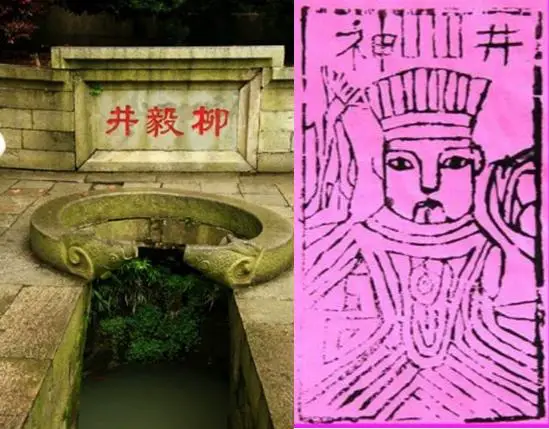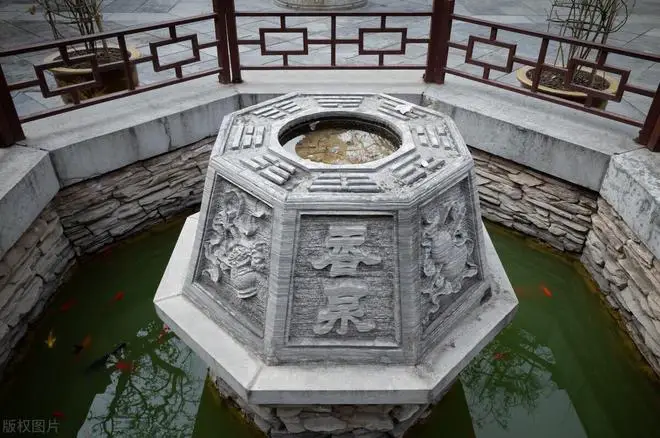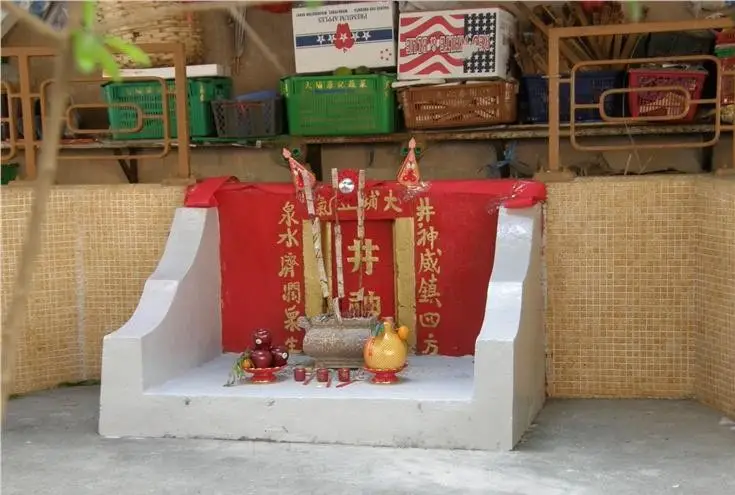The Well Deity, known as Jing Shen in Chinese folklore, is one of the deities worshipped in traditional beliefs. According to the “Baihu Tong·Wu Si” (White Tiger Register of Five Sacrifices), the five deities include Door, Gate, Well, Stove, and Earth, collectively referred to as the household deities. People have been practicing rituals for these deities since ancient times. The Well Deity, in particular, is not usually represented by statues or temples. Instead, a simple ritual is performed on the well platform.

In certain northern regions of China, there is a custom of worshipping the Water Mother Goddess. There are even temples dedicated to the Water Mother Goddess, who is said to be a youthful female Well Deity.
Worshipping the Well Deity: Beliefs and Reverence in Traditional Customs
The tradition of worshipping the Well Deity has deep roots in the vast land of China and has become ingrained in the hearts of the people. Despite regional variations, the core of this traditional belief remains consistent: a profound reverence and gratitude towards the Well Deity, coupled with a deep appreciation and hopeful prayers for the water source.

The sealing of wells on New Year’s Eve is a prevalent folk tradition in China. It is believed that on the thirtieth day of the lunar calendar, the Well Deity reports the year’s water supply situation to the East Sea Dragon King. Additionally, the first day of the lunar new year is considered a day when celestial beings descend to inspect, and people avoid drawing water on this day to avoid offending the deities. Thus, on New Year’s Eve, households conduct simple ritual ceremonies at the well, sealing the well’s opening to show respect for the Well Deity.
The dedication ceremony for newly dug wells is an even more elaborate affair. Villagers carefully choose an auspicious date in the Chinese almanac and invite elders from the community to officiate the ceremony. On the day of the ritual, the entire village gathers at the well, setting off firecrackers and offering incense for prayers. It is believed that such ceremonies usher in a year of abundant water supply and prosperity.
In addition to dedicating new wells, people also perform specific rituals to worship the Well Deity on occasions such as the Spring Festival, Qingming Festival, Dragon Boat Festival, or when a family in the village welcomes a new member. During these moments, villagers place offerings such as fruits and pastries near the well, while setting off firecrackers and burning incense to pray for the purity and safety of the water source, as well as good luck and health for their families.
In Chinese folk belief, the Well Deity is envisioned as a beautiful and pure maiden. Despite the absence of concrete statues or temples, she holds a significant place in the hearts of the people. During well worship, individuals often imagine her image, praying for her blessings of peace and health for their families.
Beyond the traditional well-worshipping customs, northern regions of China also embrace the belief in the Water Mother Goddess. Regarded as a young female Well Deity with magical powers, the folklore narrates her as a gentle and kind woman who sacrificed herself to protect the village’s water source. Consequently, she is revered as a water and well deity, earning admiration and worship from the community.
The image of the Water Mother Goddess frequently appears in Chinese folk art, including paintings, sculptures, and architecture. People believe in her ability to safeguard the purity and safety of water sources, bringing prosperity and good fortune to the village. On specific days in the lunar calendar, villagers spontaneously organize grand worship activities to commemorate the Water Mother Goddess. These events feature elaborately crafted offerings, lanterns, firecrackers, incense, songs, and dances expressing reverence and gratitude towards her.
As times change and society evolves, many traditional customs are gradually forgotten or overlooked. However, the tradition of worshipping the Well Deity persists in Chinese folk culture. This enduring practice is not only rooted in the dependence on water sources and the pursuit of health but also embodies profound cultural and spiritual values. Through the ritual of well worship, people gain a deeper understanding of their cultural heritage and historical traditions while promoting a society characterized by unity, mutual assistance, and harmony.
Legend of the Well Deity
One of the most famous Well Deities in Chinese folklore is Liuyi from Liuyi Well, located in the Longkou area of Mount Junshan by Dongting Lake. The well was originally surrounded by a large tangerine tree, hence its alternate name “Citrus Well.” According to the records in “Baling County Chronicles,” Citrus Well is the place where Liuyi, a scholar during the Yifeng period of the Tang Dynasty, descended into the Dragon Palace beneath Dongting Lake. On his way back from the imperial examination in the capital, Liuyi encountered a shepherdess covered in wounds near Jingyang.
Upon inquiry, he learned that she was the daughter of the Dragon Lord of Dongting, married to the Little Dragon of Jingyang, and had fled due to mistreatment. Entrusted by the dragoness, Liuyi arrived at Dongting Lake, found Citrus Well on Mount Junshan, descended into the Dragon Palace, and informed the Dragon Lord’s brother, Qiantang Dragon Lord, about the unfortunate plight of the Little Dragoness. Enraged, Qiantang Dragon Lord transformed into a hundred-foot red dragon and went to vanquish the Little Dragon of Jingyang, rescuing the dragoness.

Subsequently, the Dragon Lord invited Liuyi to become his son-in-law, residing in the water palace of Dongting and overseeing the passage between the water palace and the human realm – Citrus Well. Thus, Liuyi became a well-celebrated Well Deity in the local folklore.
In “Ba Ze Tu Kao,” it is mentioned that the Well Deity is observed to have a beautiful female form and delights in playing the flute, described as a “flute-playing maiden” in “Ji Liu Bian.”
A tale from the Ming Dynasty by an anonymous author in “Hu Hai Xin Wen Yi Jian Xu Zhi Hou Ji” in Volume Two, titled “The Manifestation of the Well Deity,” describes the Well Deity as a female figure. The story revolves around a solitary man named Wu Zhan living near Jingxi in Yixing. There was a clear and sweet spring nearby that attracted many people for water. Wu Zhan constructed a bamboo fence to protect the spring, preventing dust and impurities from entering, which deeply moved the spring deity.
One day, Wu Zhan found a white shell by the spring and placed it in his home. From that day on, whenever he returned, meals were magically prepared in his kitchen. Perplexed, Wu Zhan secretly returned home one day to investigate and witnessed a woman emerging from the shell, cutting vegetables, and cooking. Startled by his sudden presence, the woman confessed to being the spring deity. She explained that, due to his respectful care of the spring source and his solitary lifestyle, she had come to prepare meals for him. She promised that consuming the meals she prepared would lead him to attain immortality. With those words, she disappeared suddenly.
This story is believed to be a variant of the widely circulated Chinese folk narrative known as the “Shell Maiden Story.” The connection between well water and spring deity is evident in this tale, portraying the well deity.
In the Wu region, there is also the belief in the Well Deity, referred to as the “Bing Quan Tong Zi,” indicating that the Well Deity is a child. In Suzhou custom, on the eve of the Chinese New Year, a previously purchased statue of the Well Deity is placed in a bamboo sieve. Offerings such as cakes, fruits, tea, and alcohol are presented as sacrificial items. The bamboo sieve is then placed on the well railing, covered with a protective layer. This ritual, known as “Sealing the Well,” means that the well cannot be used until the deity is sent off. The deity is usually sent off by burning incense and offerings on the third or fifth day of the lunar new year, allowing the well to be reopened for use. It is believed that wiping the eyes with water drawn from the recently opened well can prevent eye diseases.
According to the Ming scholar Zhu Guozhen in his work “Zhuang Xiao Pin,” there is a tale of a well deity who is a malevolent spirit. In the early Song Dynasty, a shaman named Guo performed rain-making rituals at the well, using a white ox horn as his instrument. During one such ritual, the horn fell into the well. Guo descended to retrieve it and discovered a palace with an elderly man seated within, surrounded by guards. The old man explained that he was the Dragon King and that Guo’s clamor disturbed the heavens, leading him to confiscate the ox horn. After promising not to disturb the Dragon King further, Guo retrieved the ox horn. However, unable to resist the lure of a lucrative business opportunity, Guo repeated the disturbance, and this time, he never returned alive. His body was found floating in the nearby stream, inexplicably preserved and untouched by decay. In a dream, Guo revealed that the Dragon King had prohibited him from returning to the mortal realm. Still, the Dragon King appointed him as the guardian of the well shrine, and a shrine was erected to commemorate him. It is said that prayers to this well deity are answered, making the shrine a place of spiritual significance.
In summary, the diverse tales of well deities in Chinese folklore reveal the cultural significance attached to water sources, emphasizing themes of respect, reciprocity, and the mystical connection between humanity and nature.
